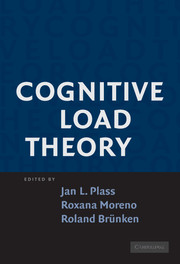Book contents
- Frontmatter
- Contents
- Contributors
- COGNITIVE LOAD THEORY
- Introduction
- PART ONE THEORY
- PART TWO EMPIRICAL EVIDENCE
- PART THREE DISCUSSION
- 9 Measuring Cognitive Load
- 10 From Neo-Behaviorism to Neuroscience: Perspectives on the Origins and Future Contributions of Cognitive Load Research
- 11 Cognitive Load in Learning with Multiple Representations
- 12 Current Issues and Open Questions in Cognitive Load Research
- Index
- References
11 - Cognitive Load in Learning with Multiple Representations
Published online by Cambridge University Press: 05 June 2012
- Frontmatter
- Contents
- Contributors
- COGNITIVE LOAD THEORY
- Introduction
- PART ONE THEORY
- PART TWO EMPIRICAL EVIDENCE
- PART THREE DISCUSSION
- 9 Measuring Cognitive Load
- 10 From Neo-Behaviorism to Neuroscience: Perspectives on the Origins and Future Contributions of Cognitive Load Research
- 11 Cognitive Load in Learning with Multiple Representations
- 12 Current Issues and Open Questions in Cognitive Load Research
- Index
- References
Summary
Technological innovations have led to important changes in teaching and learning during the last decade. Advances in computer technology have enabled the development of flexible learning arrangements, Web-based collaboration, and a broad range of multimedia learning environments. Multimedia allows the combination of different presentation formats, such as pictures, animations, text, or music in flexible ways via different sensory modalities. Media designers often assume that multimedia allows for a better adaptation of instruction to the learners' needs and preferences. Multimedia is also expected to motivate learners, thus increasing their invested cognitive effort, which in turn should result in better learning.
A major topic in the field of learning and instruction is how multimedia instruction interacts with the human cognitive architecture. Mayer (2001, 2005) as well as Schnotz (2001, 2005; Schnotz & Bannert, 2003) have developed theoretical models of multimedia learning that address this issue. Both models aim to explain what goes on in the mind of the learner when he or she learns from spoken or written texts with static or animated pictures. Both models share the assumption that the type and amount of presented information has to be adapted to the limitations of the cognitive system, especially those of working memory. The same assumption is at the core of Cognitive Load Theory (CLT) developed by Sweller and colleagues, which has become increasingly influential in instructional psychology during the last decade (Chandler & Sweller, 1991; Paas, Renkl, & Sweller, 2004; Paas & van Gog, 2006; Sweller, 1994, 2005; Sweller, van Merriënboer, & Paas, 1998).
- Type
- Chapter
- Information
- Cognitive Load Theory , pp. 229 - 252Publisher: Cambridge University PressPrint publication year: 2010
References
- 9
- Cited by



